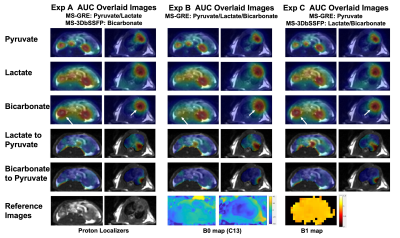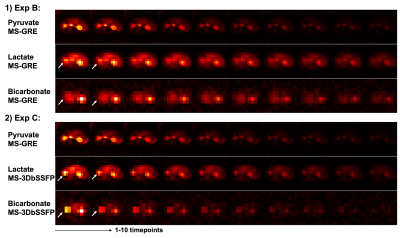3563
A Metabolite Specific 3D Stack-of-Spiral bSSFP Sequence for Improved 13C-Bicarbonate Imaging in Hyperpolarized [1-13C]Pyruvate MRI1University of California San Francisco, San Francisco, CA, United States, 2HeartVista, Los Altos, CA, United States
Synopsis
MRI of hyperpolarized 13C-labeled compounds is an emerging tool to non-invasively detect metabolic processes, and hyperpolarized [1-13C]pyruvate has been used in clinics for assessing cancer and cardiac metabolism. However, due to nonrenewable and progressively depleted magnetization, hyperpolarized 13C has a limitation to achieve both high spatial resolution and temporal resolution with high SNR. This study proposes a novel bicarbonate-specific 3D bSSFP sequence with stack-of-spiral readout to improve the SNR of dynamic bicarbonate imaging in hyperpolarized [1-13C]pyruvate studies. Compared to a metabolite-specific GRE sequence, the proposed MS-3DbSSFP sequence showed a 3X SNR improvement for bicarbonate imaging in rat heart and kidneys.
Introduction
MRI of hyperpolarized 13C-labeled compounds is an emerging tool to non-invasively detect metabolic processes, and hyperpolarized [1-13C]pyruvate has been used in clinics for assessing cancer and cardiac metabolism.[1,2] However, hyperpolarized magnetization is nonrenewable and depleted by T1 as well as RF pulses, thus hyperpolarized 13C MRI has limitations to achieve both high resolution and high SNR. In hyperpolarized [1-13C]pyruvate studies, imaging 13C-bicarbonate provides a valuable biomarker of Krebs cycle metabolism, but is limited by the low concentration of 13C-bicarbonate. To improve the efficiency of using hyperpolarized magnetization, balanced steady-state free precession(bSSFP)[3-6] sequences have been used for improving 13C-lactate imaging.[7] In this study, a novel bicarbonate-specific 3D bSSFP with stack-of-spiral readout is proposed to improve the SNR of dynamic bicarbonate imaging in hyperpolarized [1-13C]pyruvate studies.Methods
Sequence: The proposed 3D bSSFP sequence(Fig.1) consists of a spectrally-selective RF pulse, catalyzation RF pulses, and a center-out uniform density stack-of-spiral readout. The RF pulse was designed to excite bicarbonate signal by a published multiband RF pulse design approach[7,8] to minimize pulse duration. The duration of this pulse is 4.2ms, and maximum B1 is 0.21G. The catalyzation consists of six identical pulses with nonlinear amplitude increments to achieve a stable frequency response from the first readout. Considering tradeoffs between banding artifacts and residual magnetization for dynamic metabolic imaging, the flip angle was set to $$$60^{\circ}$$$.The 3D stack-of-spiral readout with 4 interleaves has 16 stacks for kz encoding. All gradients have been balanced in each TR. The optimal TR is 9.8ms to maximize the distance between banding artifacts frequencies and metabolite frequencies. The proposed sequence was implemented on a GE 3T scanner(Waukesha, WI) using commercial software(RTHawk, HeartVista, CA).
Simulation: Fig.3 is the Bloch simulation of the proposed RF pulse excitation profile with bSSFP readout. Simulation parameters: 6 catalyzation RF pulses, T1=30s, T2=1s, TR=9.8ms, number of TR=64, flip angle=$$$60^{\circ}$$$. The excitation profile was shown as the averaged transverse magnetization of all bSSFP acquisitions.
Phantom Study: To measure the excitation profile of the proposed RF pulse, we excited a urea pencil phantom with different frequencies and measured its signal curve. Data were acquired by a mouse coil with the parameters: phantom diameter=1cm, resolution=1x1cm2, TR=500ms, flip angle=$$$60^{\circ}$$$, NEX=400.
Animal Study: Animal studies were performed on a healthy Sprague-Dawley rat with three identical injections of hyperpolarized [1-13C]pyruvate(SpinLab, GE healthcare) to compare metabolite-specific 3D bSSFP sequences(MS-3DbSSFP) with metabolite-specific gradient echo sequences(MS-GRE). Data were acquired by a single channel rat coil. Experiment A: pyruvate, lactate data were acquired by MS-GRE, resolution 2.5mm/5mm, slice thickness 21mm, 8 slices, flip angle $$$20^{\circ}/30^{\circ}$$$; bicarbonate data was acquired by MS-3DbSSFP, resolution 7.5mm, slice thickness 21mm, 16 slices, flip angle $$$60^{\circ}$$$, temporal resolution 2.4s. Experiment B: pyruvate, lactate, bicarbonate data were acquired by MS-GRE, flip angle $$$20^{\circ}/30^{\circ}/30^{\circ}$$$, same spatial resolution respectively, temporal resolution 2.4s. Experiment C: pyruvate data was acquired by MS-GRE, flip angle $$$20^{\circ}$$$, same spatial resolution; lactate, bicarbonate data were acquired by MS-3DbSSFP, 16 slices, flip angle $$$60^{\circ}/60^{\circ}$$$, same spatial resolution respectively, temporal resolution 2.8s.
Results
Fig.2 shows Bloch simulation of excitation profile and urea pencil phantom results. The normalized signal of urea phantom was indicated by the blue cross points, demonstrating the reasonability of the simulated excitation profile.Fig.3 shows the quality results of MS-3DbSSFP approach with an animal study. The MS-3DbSSFP lactate sequence[7] was a prior approach for comparison. The bicarbonate MS-3DbSSFP images show similar distributions to the MS-GRE images. No apparent change was observed in the pyruvate MS-GRE across the experiments. Based on the field map, the right kidney suffers from larger B0 inhomogeneity, leading to a more severe off-resonance blurring artifact for MS-GRE, whereas the MS-3DbSSFP has sharper edges due to a shorter readout length. The cardiac slice has the same phenomenon.
Fig.4 compares the dynamic renal images acquired by MS-GRE and MS-3DbSSFP sequences. Consistent with the AUC images(Fig.3), the right kidney is sharper acquired by MS-3DbSSFP sequence. With a shorter readout time, MS-3DbSSFP sequence suffers less off-resonance effect than MS-GRE sequence. Due to shorter expected T2* and intrinsic low signal of bicarbonate, bicarbonate data were acquired with larger resolutions to provide sufficient SNR.[9] Therefore, bicarbonate images suffer from larger off-resonance effect than lactate images, which leads to a more pronounced blurring artifact in MS-GRE images.
Fig.5 shows dynamic curves of pyruvate, lactate, and bicarbonate signals in an animal study. All signals have been normalized by the first timepoint pyruvate signal of each injection and corresponding noise signals. In both heart and kidney slices, MS-3DbSSFP bicarbonate sequence shows an around 3X SNR improvement over the MS-GRE bicarbonate sequence, demonstrating a higher SNR performance due to refocusing of the 13C-bicarbonate signal. Both MS-3DbSSFP lactate sequence and MS-3DbSSFP bicarbonate sequence have similar signal decay rates as signal decay rate of the MS-GRE sequences, indicating the magnetization is well-preserved for dynamic imaging.
Discussion & Conclusion
This work describes a novel 3D bSSFP sequence with bicarbonate-specific excitation pulse and stack-of-spiral readout for improving the SNR of bicarbonate-specific imaging in hyperpolarized [1-13C]pyruvate studies. Comparing with MS-GRE sequence, proposed MS-3DbSSFP sequence showed an approximately 3X SNR improvement for bicarbonate imaging in rat heart and kidneys, representing a major improvement for observing this low concentration metabolite that provides measurements of pyruvate oxidation.Acknowledgements
This work was supported by NIH Grants P41EB013598, R21DK130002, R01CA249909 and American Cancer Society Grant RSG‐18‐005‐01‐CCE.References
[1] Ardenkjær-Larsen, Jan H., et al. "Increase of signal-to-noise of more than 10,000 times in liquid state NMR." Discovery medicine 3.19 (2003): 37-39.
[2] Golman, Klaes, and Mikkel Thaning. "Real-time metabolic imaging." Proceedings of the National Academy of Sciences 103.30 (2006): 11270-11275.
[3] Svensson J. Hyperpolarized 13C MR angiography using trueFISP. Magn Reson Med 2003;50.
[4] Leupold J, Månsson S, Petersson JS, et al. Fast multiecho balanced SSFP metabolite mapping of 1H and hyperpolarized 13C compounds. MAGMA 2009;22:251–6.
[5] von Morze C, Sukumar S, Reed GD, et al. Frequency-specific SSFP for hyperpolarized 13C metabolic imaging at 14.1 T. Magn Reson Imaging 2013;31:163–70.
[6] Reed GD, von Morze C, Bok R, et al. High resolution (13)C MRI with hyperpolarized urea: in vivo T(2) mapping and (15)N labeling effects. IEEE Trans Med Imaging 2014;33:362–71.
[7] Tang, Shuyu, et al. "A metabolite‐specific 3D stack‐of‐spiral bSSFP sequence for improved lactate imaging in hyperpolarized [1‐13C] pyruvate studies on a 3T clinical scanner." Magnetic resonance in medicine 84.3 (2020): 1113-1125.
[8] Shang, Hong, et al. "Multiband RF pulses with improved performance via convex optimization." Journal of Magnetic Resonance 262 (2016): 81-90.
[9] Gordon, Jeremy W., et al. "A variable resolution approach for improved acquisition of hyperpolarized 13C metabolic MRI." Magnetic resonance in medicine 84.6 (2020): 2943-2952.
Figures




